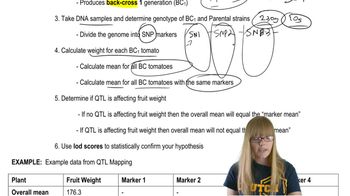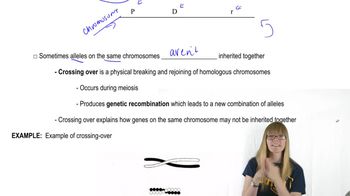Both QTL mapping and association (GWA) mapping are used to locate genes responsible for a phenotype. Which of the two techniques does NOT require crosses to produce a mapping population
Table of contents
- 1. Introduction to Genetics51m
- 2. Mendel's Laws of Inheritance3h 37m
- 3. Extensions to Mendelian Inheritance2h 41m
- 4. Genetic Mapping and Linkage2h 28m
- 5. Genetics of Bacteria and Viruses1h 21m
- 6. Chromosomal Variation1h 48m
- 7. DNA and Chromosome Structure56m
- 8. DNA Replication1h 10m
- 9. Mitosis and Meiosis1h 34m
- 10. Transcription1h 0m
- 11. Translation58m
- 12. Gene Regulation in Prokaryotes1h 19m
- 13. Gene Regulation in Eukaryotes44m
- 14. Genetic Control of Development44m
- 15. Genomes and Genomics1h 50m
- 16. Transposable Elements47m
- 17. Mutation, Repair, and Recombination1h 6m
- 18. Molecular Genetic Tools19m
- 19. Cancer Genetics29m
- 20. Quantitative Genetics1h 26m
- 21. Population Genetics50m
- 22. Evolutionary Genetics29m
20. Quantitative Genetics
QTL Mapping
Problem 20
Textbook Question
An association of racehorse owners is seeking a new genetic strategy to improve the running speed of their horses. Traditional breeding of fast male and female horses has proven expensive and time-consuming, and the breeders are interested in an approach using quantitative trait loci as a basis for selecting breeding pairs of horses. Write a brief synopsis (∼50 words) of QTL mapping to explain how genes influencing running speed might be identified in horses.
 Verified step by step guidance
Verified step by step guidance1
Quantitative Trait Loci (QTL) mapping is a method used to identify regions of the genome associated with specific traits, such as running speed in horses.
Step 1: Begin by selecting a population of horses with varying running speeds and genetic diversity.
Step 2: Measure the running speed of each horse and collect DNA samples for genotyping.
Step 3: Use molecular markers (e.g., SNPs or microsatellites) to map genetic variations across the genome.
Step 4: Perform statistical analysis to correlate genetic markers with variations in running speed, identifying loci that influence the trait.
Step 5: Validate the identified QTLs by further testing or breeding experiments to confirm their impact on running speed.
 Verified video answer for a similar problem:
Verified video answer for a similar problem:This video solution was recommended by our tutors as helpful for the problem above
Video duration:
2mPlay a video:
Was this helpful?
Key Concepts
Here are the essential concepts you must grasp in order to answer the question correctly.
Quantitative Trait Loci (QTL)
Quantitative Trait Loci (QTL) are specific regions of the genome that are associated with a particular quantitative trait, such as running speed in horses. By identifying these loci, breeders can understand the genetic basis of traits and select breeding pairs that carry favorable alleles to enhance desired characteristics.
Recommended video:
Guided course

QTL Mapping
Genetic Mapping
Genetic mapping involves determining the location of genes on chromosomes and their relationship to traits. In QTL mapping, researchers use statistical methods to correlate phenotypic data (like speed) with genotypic data (DNA markers), allowing them to pinpoint the genetic factors influencing the trait.
Recommended video:
Guided course

Mapping Overview
Marker-Assisted Selection
Marker-Assisted Selection (MAS) is a breeding technique that uses genetic markers linked to desirable traits to select individuals for breeding. By employing QTL mapping, breeders can utilize MAS to efficiently choose horses that possess genetic markers associated with improved running speed, thereby accelerating the breeding process.
Recommended video:
Guided course

Mapping with Markers
Related Videos
Related Practice
Multiple Choice
436
views
1
rank


